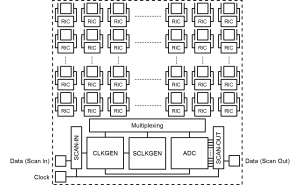An On-Chip Test Circuit for Characterization of MEMS Resonators
- Category: Circuits & Systems, MEMS & BioMEMS
- Tags: Dana Weinstein, Duane Boning, John Lee
Electromechanical resonators such as quartz crystals, surface acoustic wave (SAW) resonators, and ceramic resonators have become essential components in electronic systems. However, due to their large footprint and difficulty in integrating with CMOS processes, there has been much interest in developing microelectromechanical systems (MEMS) resonators that achieve comparable performance yet have smaller footprint and are compatible with CMOS. Recently, MEMS resonators have been proposed that overcome physical limitations in traditional resonators to reach frequencies in the GHz range. In addition, they have the potential for compatibility with CMOS, opening up possibilities for new circuits and systems [1] . As with other semiconductor devices, with increasing frequency and with decreasing device size into the submicron scale, variability has started to become a critical issue in MEMS resonators. Thus vigorous characterization of important device parameters such as resonant frequencies, quality factors, and variations associated with them has become necessary. However, one of the critical challenges is the lack of a characterization method that is accurate but efficient enough to be used for testing of the large number of devices necessary to acquire accurate statistical distribution of the parameters of interest. This project proposes an on-chip test circuit that can accurately characterize a large number of resonators for variation analysis. The desired test circuit is general enough that it can be used with a wide range of resonators, not limited to specific frequencies or other properties. Previous works have attempted to achieve similar goals, but most of them were restricted to characterization of a single device or a narrow range of properties. The proposed test circuit is based on a transient step response method using a voltage step that can accurately measure the resonant frequencies and the quality factor of devices [2] . The circuit employs a sub-sampling method to capture the high-frequency decay signal [3] and a simple analog-to-digital converter (ADC) [4] allowing complete digital interface, an important feature for test automation.
- Figure 1: Excitation circuit consisting of six transistors that allows all measurements necessary for model parameter extraction and can be used with the sub-sampling technique required to sample high-frequency resonator response signal.
- Figure 2: System block diagram for integrated MEMS resonator characterization test circuit.
- D. Weinstein and S. A. Bhave, “The resonant body transistor,” Nano Letters, vol.10, no. 4, pp. 1234-37, 2010. [↩]
- M. Zhang, N. Llaser, H. Mathias, and F. Rodes, “CMOS offset-free circuit for resonator quality factor measurement,” IEEE Electronic Letters, vol. 46, no. 10, p. 706, May 2010. [↩]
- R. Ho et al., “Applications of on-chip samplers for test and measurement of integrated circuits,” in Proc. 1998 IEEE Symposium on VLSI Circuits, June, pp. 138-139. [↩]
- E. Alon, V. Stojanović, and M. A. Horowitz, “Circuits and techniques for high-resolution measurement of on-chip power supply noise,” IEEE Journal of Solid-State Circuits, vol. 40, no. 4, pp. 820-828, Apr. 2005. [↩]

